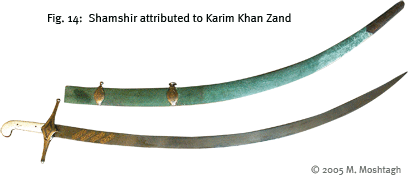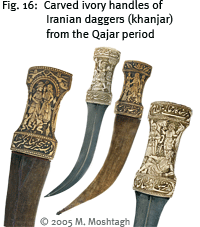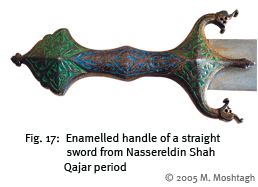Illustrated within the treatise are different swords with the signature of Assadollah. Each signature is meticulously scrutinized, and a careful analysis of royal pieces shows that there are different styles of handwriting
 and dates that accompany these cartouches. The same is true with the signature of Kalbeali and the different styles of Kalbeali cartouches that are presented. The volume explores the meaning of each one of these names in its cultural setting and concludes that these names would have been used as honorary titles. Other smiths, such as Askari Isfahani signed, their blades with
and dates that accompany these cartouches. The same is true with the signature of Kalbeali and the different styles of Kalbeali cartouches that are presented. The volume explores the meaning of each one of these names in its cultural setting and concludes that these names would have been used as honorary titles. Other smiths, such as Askari Isfahani signed, their blades with
their own names. The research shows that double-edged swords were not abandoned after the introduction of curved swords; rather, they coexisted t ogether into the Qajar period. However, the curved swords were generally favored. A beautiful, double-edged sword with a watered blade, enameled handle, and gold-inlaid cartouche from Nassereldin Shah Qajar shows the beauty of these swords. A chapter of this book is dedicated to the meaning of dragons, which appear on the ends of the quillons of many of these straight swords. Another important topic dealt with are the images of the lion and the sun and its meaning for Iranian dynasties. As it will be shown, the emblem of the lion and the sun has a long tradition, going back to the Saljug times. The image also appears on some coins from the Safavid era, known as “folus.” The engraved forte of a shamshir with the symbol of the lion and the sun from the Safavid period is photographed. Contrary to the popular belief, the symbol existed before the Qajar era and not only appeared on coins but also on sword blades.
ogether into the Qajar period. However, the curved swords were generally favored. A beautiful, double-edged sword with a watered blade, enameled handle, and gold-inlaid cartouche from Nassereldin Shah Qajar shows the beauty of these swords. A chapter of this book is dedicated to the meaning of dragons, which appear on the ends of the quillons of many of these straight swords. Another important topic dealt with are the images of the lion and the sun and its meaning for Iranian dynasties. As it will be shown, the emblem of the lion and the sun has a long tradition, going back to the Saljug times. The image also appears on some coins from the Safavid era, known as “folus.” The engraved forte of a shamshir with the symbol of the lion and the sun from the Safavid period is photographed. Contrary to the popular belief, the symbol existed before the Qajar era and not only appeared on coins but also on sword blades.
